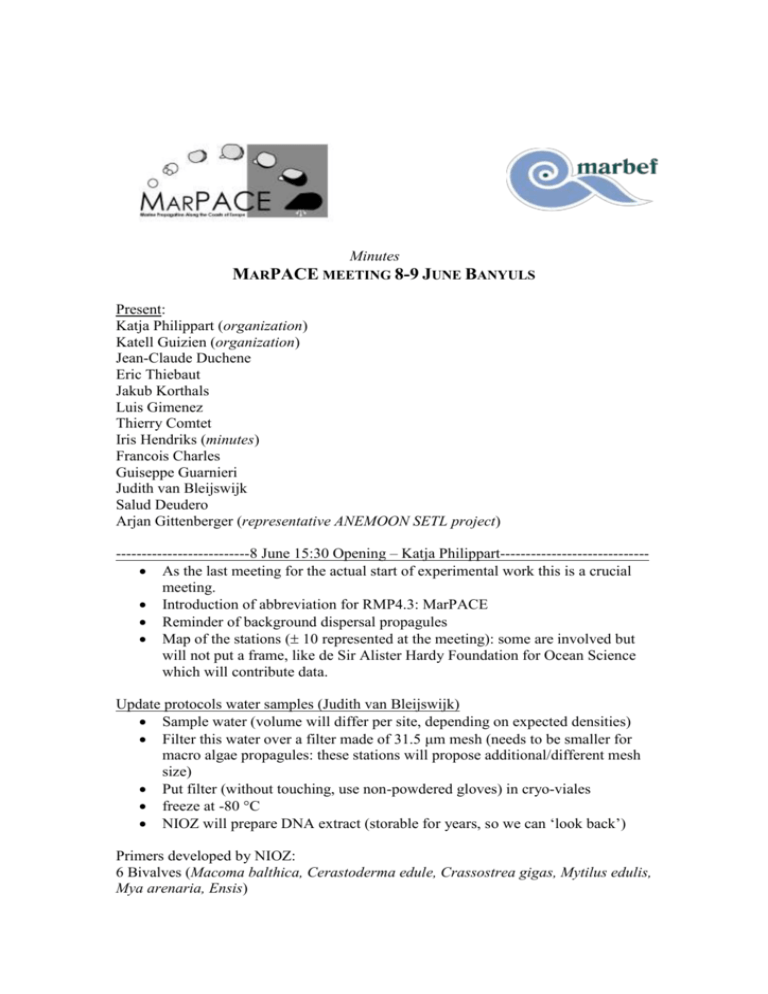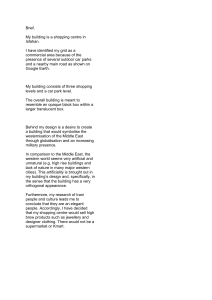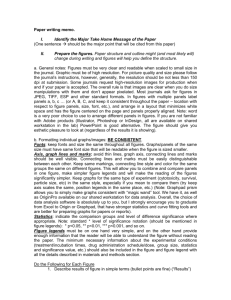Minutes of the meeting
advertisement

Minutes MARPACE MEETING 8-9 JUNE BANYULS Present: Katja Philippart (organization) Katell Guizien (organization) Jean-Claude Duchene Eric Thiebaut Jakub Korthals Luis Gimenez Thierry Comtet Iris Hendriks (minutes) Francois Charles Guiseppe Guarnieri Judith van Bleijswijk Salud Deudero Arjan Gittenberger (representative ANEMOON SETL project) --------------------------8 June 15:30 Opening – Katja Philippart---------------------------- As the last meeting for the actual start of experimental work this is a crucial meeting. Introduction of abbreviation for RMP4.3: MarPACE Reminder of background dispersal propagules Map of the stations ( 10 represented at the meeting): some are involved but will not put a frame, like de Sir Alister Hardy Foundation for Ocean Science which will contribute data. Update protocols water samples (Judith van Bleijswijk) Sample water (volume will differ per site, depending on expected densities) Filter this water over a filter made of 31.5 μm mesh (needs to be smaller for macro algae propagules: these stations will propose additional/different mesh size) Put filter (without touching, use non-powdered gloves) in cryo-viales freeze at -80 °C NIOZ will prepare DNA extract (storable for years, so we can ‘look back’) Primers developed by NIOZ: 6 Bivalves (Macoma balthica, Cerastoderma edule, Crassostrea gigas, Mytilus edulis, Mya arenaria, Ensis) Can NIOZ develop a primer for polychaete larvae (Q Katell)? – Answer: only if time/difficulty permits. Can NIOZ develop a primer for Pinna nobilis (Q Iris)? – easier because already bivalve database Remark (Arjan): development on dry-storaging techniques for DNA (USA) Shortlist for species to look at in water samples Requisites for listing: present in more than one station (pan-european), potential different reproduction period through these stations, should settle on the plates, someone should be willing to do the analysis of the data (with respect to population dynamics, life-cycle, etc.). Bivalves: o Crassostrea gigas, Mytilus edulis (NIOZ) o Pinna nobilis (IMEDEA) Polychaetes o Ditrupa aretina (OBS) o Pomateceros (OBS) Barnacles (Steve Hawkins? Katja will ask him) o Semibalanus balanoides o Balanus amphitrita o purple striped barnacle (Arjan will look at the Latin name) Macro-algae DNA sequences present (Myriam Valero-Roscoff, PortugalFaro), cost-sharing with NIOZ?: o Laminaria, o Undularia (invasive), o Sacchoryza Hydroids (Unile? Katja will check with Nando) posible expansion: Megalope (crab) larvae Ascidians? GBIRM (RMP4.1) can be asked if DNA sequences for these species are known/can be developed (call for participation). Also info on cryptic species could be obtained. Interested parties should write a justification for including ‘their’ species with geographic range, spawning period, morphology, description etc. Update protocol Panels Remaining questions 1. Design (frames vs. panels) 2. Positioning in water column 3. Additional instruments 4. what to ID (all species, or a selection) 5. division of work on molecular analyses 6. secondary settlers: timing of replacement plates 7. latitudinal and seasonal sampling (frequency) 8. gaps in latitudinal gradient 9. FP7 proposal Decisions Sampling design put relative to water surface (not bottom), panels to be put at 1 meter deep for Atlantic stations, 2 meters (or 3?) for Mediterranean stations, total height of water column should be preferably between 3 and 5 meters Photograph plates and ID ALL present species (expected <10) to species level; water samples will only be analyzed for a selection of species ID using standard books*, if unsure send to expert (in tube) Reference collection (plants & animals) to be stored in Naturalis, NL Reference collection (photos) on MarPACE website Deployment of panels on exact date: 15 September 2006 (date of placement matters for succession), 15 December 2006, 15 March 2007, 15 June 2007, and 15 September 2007. Sampling period for primary settlers: starting 15 September, every two weeks. Sample as long as season permits (e.g. take out panels in case of ice cover, and put them back in when ice disappears) Sampling period for secondary settlers every 3 months, coinciding with SETL project (Smithsonian and ANEMOON), starting 15 September FP7 proposal, RMP results to be used as pilot study, set-up for proposal, PhD students and more money when successful Remark (Arjan): sampling in moon-fase more successful than in 14 days scheme. Remaining question: at what depths should the water samples be taken? – same as panel depth? *Identification guides: Atlantic Handbook of the Marine Fauna of North-West Europe, editors Peter J Hayward, John S Ryland. ISBN: 0198540558 - Oxford University Press. Mediterranean Riedl, R. 1983. Fauna und Flora des Mittelmeeres. Parey. (Note: this book is not available in stores!!!!) All follow the basic sampling scheme, if labs want to elaborate (e.g. compare deployment height etc.), please inform Katja of need for more panels than basic number. ------------------------------------coffee break---------------------------------------------Presentation Katell 17:20 Frame deployment in Banyuls Experimental roughness of panels: sandpapered (200 μm) panels more successful than smooth panels Modified frame design: buoy at the side instead of centre (for diver access) collection device for panels Frame at 3 (?) m depth at site with 27 local depth freshwater input at site forgotten moorings: depth gradient for settlers (>20 m no mussels) Presentation Salud 17:35 Frame deployment in Mallorca all sampling location requirements covered (~5 m depth, no freshwater input) deviations: panels at 3 meter to minimize damage by boats, white panels instead of grey Discussion about frame design: settlers on frame itself might influence settlers on panels (overgrow) Presentation Arjan 17:51 The SETL project – a marine fouling community project single panels deployed hanging on bricks, 1 m below low-low waterline in ports, shellfish farms, extreme environments (man-made), to detect invading species (early warning system) panels checked every 3 months (next date 15 September) collaboration with, USA (Smithsonian), NL (similar circumstances: temperate waters), possibly with Japan and New Zealand volunteer-based, ID by photo’s (>6Mpixel), experts 1 m distance between panels panel area 14 x 14 cm only underneath panels The ANEMOON website could be linked on the RMP page for easy access to photos and descriptions Presentation Jean-Claude Duchene 18:40 Actographic system Determining activity of animals, image processing system sequences of pictures make a movie which can be analyzed by complex software Application for RMP: e.g. effect of influence of animals on secondary settlers? interested people can send films to Jean-Claude for analysis Thierry Comtet 19:05 Molecular ID of bivalve larvae + DNA adults to determine larvae + lots of sequences available - fixative tricky (alcohol can explode larvae) - critical step = sampling larvae methods o barcoding o in situ hybridization whole larvae target 18S rDNA modified oligonucl. PCR-RFLP technique: Comtet T, et al. (2000) Molecular and morphological identification of settlement-stage vent mussel larvae, Bathymodiolus azoricus (Bivalvia: Mytilidae), preserved in situ at active vent fields on the Mid-Atlantic Ridge. Limnol Oceanogr 45:1655–1661 ---------------------------------9 June------------------------------------------------------Practical part: 2 groups 1) actographic demonstration with collected panels 2) Identification species on panels Panels collected from Wadden Sea (2 wks, Katja), Banyuls (3 wks, Katell), Mallorca (3 wks, Salud & Iris). 1) Result: activity patterns of egg laying nudibranch Eubranchium exiguus 2) Results: Banyuls-panels Eubranchium exiguus (photo identification by Peter van Bragt), Eubranchium sp., Hydroid (Obelia maticulata) Wadden Sea Hydroids, bivalve larvae, barnacles, polychaets Mallorca Algae REMINDER AGREEMENTS Protocols water samples Sample water (volume will differ per site) Filter this water over a filter made of 31.5 μm mesh (needs to be smaller for macro algae propagules: these stations will propose additional/different mesh size) Put filter (without touching, use non-powdered gloves) in cryo-vial freeze at -80 °C send to NIOZ NIOZ will prepare DNA extract (storable for years, so we can ‘look back’) Protocols panels Ultimate design: brick sandwich (Fig 1), possibly adapted (with top panel for algae) system of SETL/Smithsonian Sampling design put relative to water surface (not bottom), panels to be put at 1 meter deep for Atlantic stations, 2 meters (or 3?) for Mediterranean stations plate size 14 x 14 cm roughed panels of grey PVC bought at one site (NL) and shipped to all partners for standardizing purposes (and because it is cheaper) Temperature loggers (100 €) placed at sites Photograph plates and ID ALL present species (expected <10) to species level o category counting: 0; 1-10; 10-100 for fauna (with exact number provided if <10) o % coverage for algae (bryozoans, hydroids etc), determined from photo’s o if possible, coverage and numbers. ID using standard books*, if unsure send to expert (in tube) Reference collection to be stored in Naturalis, NL Reference collection on MarBEF site (photos) deployment of frames on exact date: 15 September (date of placement matters for succession) Sampling period for primary settlers: starting 15 September, every two weeks. Sample as long as season permits (e.g. take out panels in case of ice cover, and put them back in when ice disappears) Sampling period for secondary settlers every 3 months, coinciding with SETL project (Smithsonian and ANEMOON), starting 15 september. Measure size of settlers. 3 replicates (PS;SS) = 6 plates in the water at all times same location rules in place (shallow, etc.) FP7 proposal, RMP results to be used as pilot study, set-up for proposal, PhD students and more money when successful After full development of new protocols these will be spread to draw in new partners to fill gaps in the sampling gradient. Fig 1. brick sandwich. Two pvc panels (roughened, gray), attached to a brick with tie-wraps. Action list which 2 polychaete species should be looked at and are there primers or DNA sequences available? (Katell) are there DNA sequences/primers available for Pinna (Iris&Salud) DNA dry storage techniques: Arjan sends articles for information S. Hawkins: interested in barnacle samples? Katja asks GBIRM (RMP4.1) should be asked if DNA sequences for species on the short list are known/can be developed (call for participation) Interested parties should write a justification for including ‘their’ species for identification in water samples Reference collection on MarBEF site (photos)? Ward needs to be asked Katja monitors FP7 guidelines and themes for development proposal Arjan checks the Latin name for the purple striped barnacle cost sharing analysis macro-algae Roscoff/NIOZ: Katell and Katja write proposal Banyuls deployment of ‘shallow’ frame for reference purposes (15 m, outside reserve) Inform Katja if more panels will be needed than basic set-up. Epilogue On the way back from Banyuls a logo (see heading of minutes) was designed





